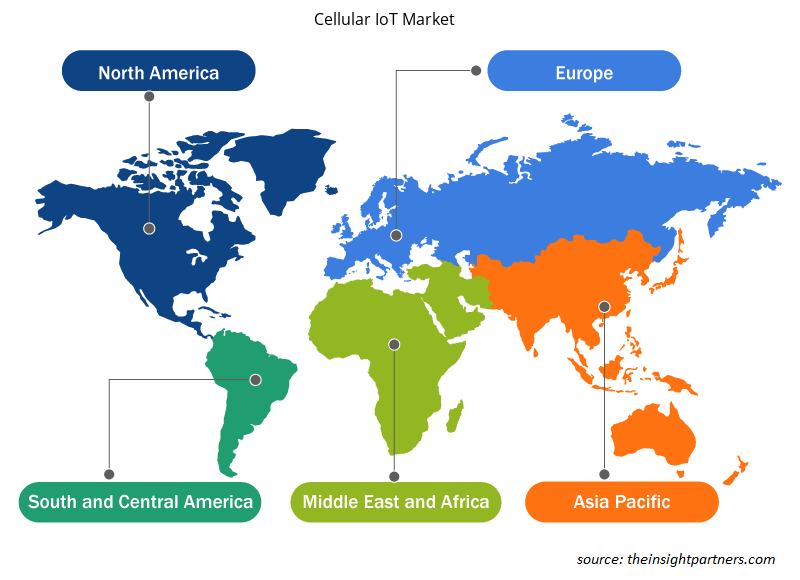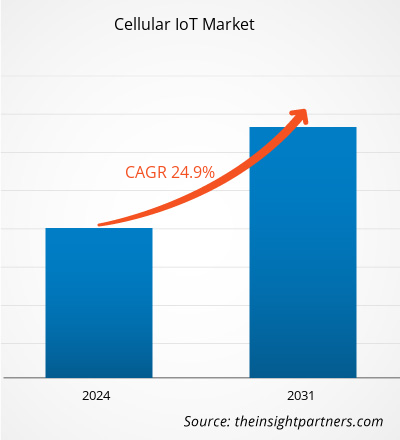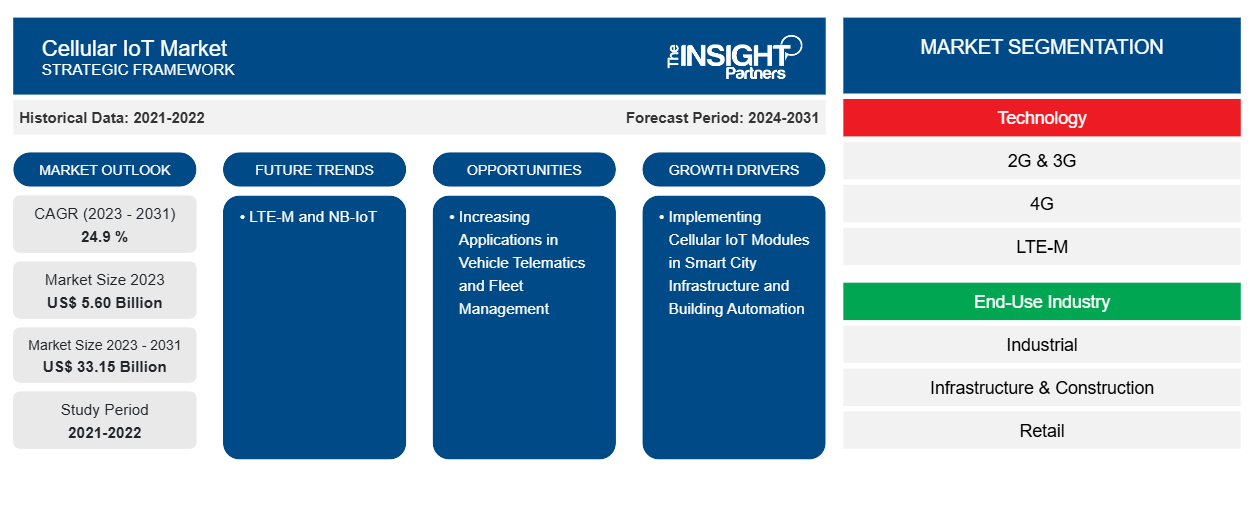Se proyecta que el tamaño del mercado de IoT celular alcance los 33.150 millones de dólares en 2031, frente a los 5.600 millones de dólares en 2023. Se espera que el mercado de IoT celular registre una CAGR del 24,9 % entre 2023 y 2031. Los módulos de IoT celular se utilizan cada vez más en la infraestructura de ciudades inteligentes y la automatización de edificios, así como en la automatización agrícola y el monitoreo ambiental, lo que impulsa la expansión del mercado.
Análisis del mercado de IoT celular
La IoT celular puede gestionar los requisitos muy sensibles y únicos de aplicaciones y configuraciones complejas, así como las necesidades más básicas del enorme mercado de IoT. Hay dos tipos principales de IoT celular: Long Term Evolution for Machines (LTE-M) e Internet de las cosas de banda estrecha (NB-IoT). Algunos ejemplos de aplicaciones de NB-IoT y LTE-M incluyen la agricultura de precisión, las ciudades inteligentes, las máquinas expendedoras, el monitoreo de flotas y otros, todos los cuales presentan perspectivas considerables para la participación de mercado de IoT celular. Estas aplicaciones requieren una comunicación de larga distancia que sea confiable y segura.
Descripción general del mercado de IoT celular
La presencia de naciones en rápido crecimiento, la creciente aceptación de tecnologías avanzadas y un número cada vez mayor de dispositivos conectados se encuentran entre las principales razones que se proyecta que impulsarán la expansión global de la IoT celular. Se prevé que el mercado global de IoT celular crezca debido al aumento de la digitalización y la automatización en industrias como la automotriz, la manufactura y la energía y los servicios públicos. Se anticipa que la mayor demanda de una cobertura de red extendida, la mayor inclinación hacia el desarrollo comercial más allá de la banda ancha móvil y la necesidad de acomodar una gran cantidad de dispositivos conectados entre las empresas de todo el mundo impulsarán el tamaño del mercado de IoT celular.
Personalice este informe según sus necesidades
Obtendrá personalización en cualquier informe, sin cargo, incluidas partes de este informe o análisis a nivel de país, paquete de datos de Excel, así como también grandes ofertas y descuentos para empresas emergentes y universidades.
-
Obtenga las principales tendencias clave del mercado de este informe.Esta muestra GRATUITA incluirá análisis de datos, desde tendencias del mercado hasta estimaciones y pronósticos.
Factores impulsores y oportunidades del mercado de IoT celular
Implementación de módulos IoT celulares en infraestructura de ciudades inteligentes y automatización de edificios para favorecer el mercado
La automatización de infraestructuras y la construcción de ciudades inteligentes son los dos despliegues verticales más importantes de módulos de IoT celular, que representan la mayor parte de los ingresos del mercado de IoT celular. Los dispositivos que funcionan con baterías ahora pueden conectarse a Internet gracias a las tecnologías emergentes de IoT celular, como NB-LTE-M, NB-IoT y 5G. Estas tecnologías conectan dispositivos de manera más efectiva que las tecnologías 2G y 3G actuales, incluido el estacionamiento inteligente y el alumbrado público inteligente. Las farolas, los dispositivos de detección y control del tráfico, los dispositivos de gestión de basura y los dispositivos de gestión de estacionamiento son solo algunos de los muchos usos de IoT celular en ciudades inteligentes. Las mejoras de infraestructura modernas son una prioridad máxima para los gobiernos de todo el mundo, y se están lanzando varios proyectos piloto para lograr este objetivo.IoT modules, accounting for the majority of the cellular IoT market's revenue. Battery-operated devices can now connect to the internet thanks to emerging cellular IoT technologies such as NB-LTE-M, NB-IoT, and 5G. These technologies connect devices more effectively than current 2G and 3G technologies, including smart parking and smart street lighting. Streetlights, traffic sensing and control devices, garbage management devices, and parking management devices are just a few of the many uses for cellular IoT in Smart Cities. Modern infrastructure improvements are a top priority for governments around the world, and several pilot projects are being launched to achieve this goal.
Aplicaciones crecientes en telemática de vehículos y gestión de flotas
La telemática vehicular es una de las nuevas aplicaciones más importantes para la IoT celular, ya que mejora el rendimiento y la conexión al mismo tiempo que utiliza los recursos de una organización. Se espera que la tendencia de implementar sistemas telemáticos en vehículos todoterreno y de carretera genere un potencial de desarrollo significativo. Cuando se trata de equipos todoterreno, como grúas y excavadoras, con un número limitado de profesionales, el tiempo es fundamental. La implementación de soluciones de IoT y telemática es necesaria para monitorear equipos y activos en la carretera. Como resultado, los proveedores de soluciones telemáticas están incorporando módulos de IoT celular en sus ofertas de productos, lo que facilita que los gerentes de flotas y los fabricantes de equipos originales de vehículos todoterreno recopilen y analicen datos de campo, tendencias y problemas.
Análisis de segmentación del informe de mercado de IoT celular
Los segmentos clave que contribuyeron a la derivación del análisis del mercado de IoT celular son la tecnología, la implementación, la industria de uso final y el usuario final.
- Según la tecnología, el mercado de IoT celular está segmentado en 2G y 3G, 4G, LTE-M, NB-IoT y 5G.
- Según la industria de uso final, el mercado de IoT celular está segmentado en industrial, infraestructura y construcción, comercio minorista, electrónica de consumo , automotriz y transporte, energía y servicios públicos, atención médica y otros.
Análisis de la cuota de mercado de IoT celular por geografía
El alcance geográfico del informe de mercado de IoT celular se divide principalmente en cinco regiones: América del Norte, Asia Pacífico, Europa, Oriente Medio y África, y América del Sur/América del Sur y Central. Países como India y China tienen una gran cantidad de distribuidores de semiconductores. Además, se prevé que la creciente entrada de empresas tecnológicas en la región, así como el aumento de la inversión en tecnologías de IoT, impulsen la expansión del mercado. Los gobiernos de los países asiáticos, como India, también están interesados en la industria de IoT celular y están implementando una serie de proyectos de infraestructura inteligente. Los gobiernos de India, Japón, China, Corea, Malasia y Singapur han promovido políticas nacionales de IoT celular.
Perspectivas regionales del mercado de IoT celular
Los analistas de Insight Partners explicaron en detalle las tendencias y los factores regionales que influyen en el mercado de IoT celular durante el período de pronóstico. Esta sección también analiza los segmentos y la geografía del mercado de IoT celular en América del Norte, Europa, Asia Pacífico, Medio Oriente y África, y América del Sur y Central.

- Obtenga datos regionales específicos para el mercado de IoT celular
Alcance del informe de mercado de IoT celular
| Atributo del informe | Detalles |
|---|---|
| Tamaño del mercado en 2023 | 5.600 millones de dólares estadounidenses |
| Tamaño del mercado en 2031 | US$ 33,15 mil millones |
| CAGR global (2023 - 2031) | 24,9 % |
| Datos históricos | 2021-2022 |
| Período de pronóstico | 2024-2031 |
| Segmentos cubiertos |
Por tecnología
|
| Regiones y países cubiertos |
América del norte
|
| Líderes del mercado y perfiles de empresas clave |
|
Densidad de actores del mercado de IoT celular: comprensión de su impacto en la dinámica empresarial
El mercado de IoT celular está creciendo rápidamente, impulsado por la creciente demanda de los usuarios finales debido a factores como la evolución de las preferencias de los consumidores, los avances tecnológicos y una mayor conciencia de los beneficios del producto. A medida que aumenta la demanda, las empresas amplían sus ofertas, innovan para satisfacer las necesidades de los consumidores y aprovechan las tendencias emergentes, lo que impulsa aún más el crecimiento del mercado.
La densidad de actores del mercado se refiere a la distribución de las empresas o firmas que operan dentro de un mercado o industria en particular. Indica cuántos competidores (actores del mercado) están presentes en un espacio de mercado determinado en relación con su tamaño o valor total de mercado.
Las principales empresas que operan en el mercado de IoT celular son:
- Arm Holdings Plc
- Compañía: AT&T, Inc.
- Ericsson
- Tecnologías Huawei Co., Ltd.
- Compañía Mediatek Inc.
- Qualcomm Incorporated
Descargo de responsabilidad : Las empresas enumeradas anteriormente no están clasificadas en ningún orden particular.

- Obtenga una descripción general de los principales actores clave del mercado de IoT celular
Noticias y desarrollos recientes del mercado de IoT celular
El mercado de IoT celular se evalúa mediante la recopilación de datos cualitativos y cuantitativos a partir de investigaciones primarias y secundarias, que incluyen publicaciones corporativas importantes, datos de asociaciones y bases de datos. A continuación, se incluye una lista de los avances del mercado:
- En mayo de 2022, Audi ofreció una actualización sobre su colaboración con la plataforma de movilidad Spoke y otros socios para emplear la tecnología celular de vehículo a todo (C-V2X) para ayudar a minimizar los accidentes que involucran bicicletas y vehículos. Además, Audi trabajó con C-V2X, que utiliza señales celulares LTE y señales PC5 directas que no requieren una red celular para detectar a un ciclista.
(Fuente: Audi, Nota de prensa, 2022)
- En enero de 2023, Sierra Wireless anunció el lanzamiento de Smart Connectivity Premium en Estados Unidos, que incluye capacidades eUICC y una cobertura de conectividad ampliada. Además, con su diseño multi-IMSI y multiperfil compatible con los requisitos eSIM (eUICC) de GSMA, Smart Connection Premium ofrece una conexión gestionada por IoT resistente y preparada para el futuro en todos los países y tecnologías mediante una única tarjeta SIM global.
(Fuente: Sierra Wireless, comunicado de prensa, 2023)
Informe sobre el mercado de IoT celular: cobertura y resultados
El informe "Tamaño y pronóstico del mercado de IoT celular (2021-2031)" proporciona un análisis detallado del mercado que cubre las siguientes áreas:
- Tamaño del mercado y pronóstico a nivel global, regional y nacional para todos los segmentos clave del mercado cubiertos bajo el alcance
- Dinámica del mercado, como impulsores, restricciones y oportunidades clave
- Principales tendencias futuras
- Análisis detallado de las cinco fuerzas de Porter y PEST y FODA
- Análisis del mercado global y regional que cubre las tendencias clave del mercado, los principales actores, las regulaciones y los desarrollos recientes del mercado.
- Análisis del panorama de la industria y de la competencia que abarca la concentración del mercado, el análisis de mapas de calor, los actores destacados y los desarrollos recientes
- Perfiles detallados de empresas
- Análisis histórico (2 años), año base, pronóstico (7 años) con CAGR
- Análisis PEST y FODA
- Tamaño del mercado, valor/volumen: global, regional y nacional
- Industria y panorama competitivo
- Conjunto de datos de Excel
Informes recientes
Informes relacionados
Testimonios
Razón para comprar
- Toma de decisiones informada
- Comprensión de la dinámica del mercado
- Análisis competitivo
- Información sobre clientes
- Pronósticos del mercado
- Mitigación de riesgos
- Planificación estratégica
- Justificación de la inversión
- Identificación de mercados emergentes
- Mejora de las estrategias de marketing
- Impulso de la eficiencia operativa
- Alineación con las tendencias regulatorias























 Obtenga una muestra gratuita para - Mercado de IoT celular
Obtenga una muestra gratuita para - Mercado de IoT celular